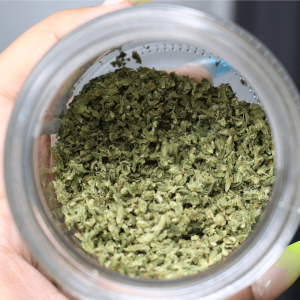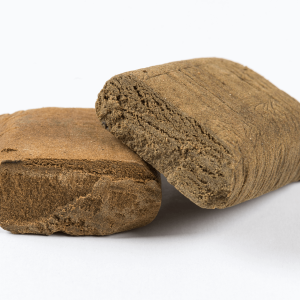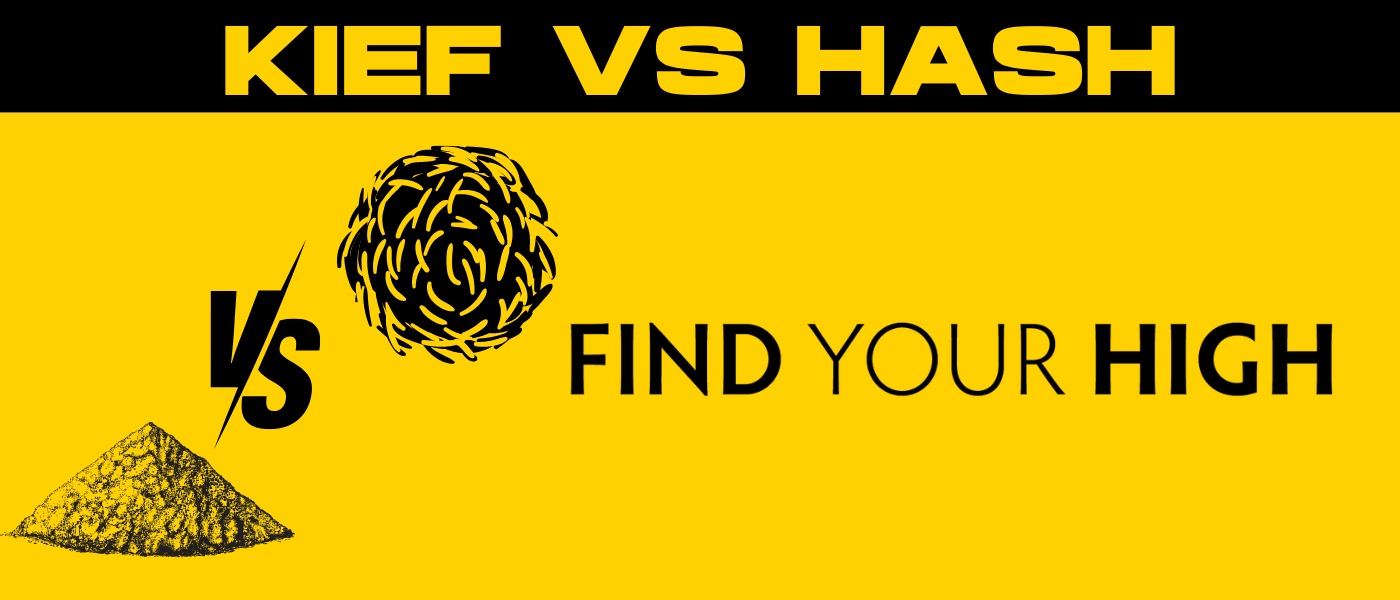Welcome to the mysterious world of kief vs. hash, two cherished cannabis treasures that have captivated enthusiasts for centuries.
This exploration will explore the fascinating differences and similarities between these potent cannabis concentrates, shedding light on their intricate production methods and diverse consumption techniques.
Curious about the rich history and cultural impact of Kief vs. Hash? Look no further.
Key Takeaways
- Kief and Hash are concentrated forms of cannabis-derived from trichome glands on buds, with distinct consistencies, uses, and potencies.
- Kief is produced using simpler methods than hash, which requires specialized equipment. Hash typically has higher THC levels (up to 90%), making it more potent.
- Popular for recreational & medicinal use, kief & hash offers a range of consumption methods with tailored potency when stored properly in cool, dark environments.

Kief and Hash Defined
Kief and hash are derived from the resinous trichome glands found on cannabis buds, which contain cannabinoids, terpenes, and flavonoids responsible for the plant’s effects and flavors.
However, these two concentrates differ in both form and consistency.
Kief, a fine substance resembling tiny crystals, differs from hash, a dense, solid block or paste formed by compressing kief or trichome glands. Such distinct properties lead to their various uses and potencies, establishing their value in cannabis products.
Kief
Kief is the accumulation of trichomes – tiny, resinous glands found on the leaves and flowers of the cannabis plant. These trichomes are packed with cannabinoids, terpenes, and flavonoids, making Kief a highly concentrated and potent form of cannabis.
A relatively simple process is often used to collect kief, involving grinders with a mesh screen known as a “kief catcher.”
After collection, kief can be used in several ways, including:
- Rolling into ‘charas’ balls
- Sprinkling over a bowl
- Integrating into a joint
- Sticking to the outside of a joint using water or saliva
Butane hash oil, a specific type of hash oil, offers a versatile range of applications for cannabis enthusiasts, similar to other cannabis concentrate forms.
Hash
In contrast to the fine powder of kief, hash is a concentrated form of cannabis made by compressing kief or resinous trichome glands, resulting in a solid block or paste. Hash comes in various forms, including:
- Traditional hash
- Bubble hash
- Dry sift hash
- Rosin
Due to the compression process, hash generally has a darker color and a more condensed consistency than kief, with a distinct flavor profile and aroma.
The concentrated nature of hash makes it a popular choice for those seeking a potent cannabis experience.
As we explore the production methods and potency comparisons between kief and hash, it becomes evident that each concentrate has unique characteristics and applications, catering to various preferences and consumption methods.

Production Methods: Kief vs. Hash
While kief and hash are derived from cannabis trichomes, their production methods differ significantly.
Kief extraction is a more straightforward process, often achieved through grinders, mesh screens, or dedicated machinery for large-scale production.
In contrast, hash production involves more complex processes, requiring specialized equipment and techniques to achieve a cohesive, concentrated form.
Comprehending kief and hash’s distinctive production methods sheds light on their traits and underscores the variety of cannabis concentrates emerging in the rapidly changing landscape of cannabis legalization.
Kief Extraction
Kief extraction can be accomplished using various methods, from simple grinders with a mesh screen (known as a “kief catcher”) for personal use to more specialized equipment for larger-scale operations, such as the Alchemist 420 by GreenBroz.
The extraction process involves using these methods to extract kief from cannabis plants, which consists of the minuscule resin glands that contain the majority of cannabinoids and terpenes present in cannabis.
These extraction techniques accommodate varying production scales, ranging from casual cannabis enthusiasts collecting kief from cannabis plant material for personal use to commercial operations targeting mass production of this potent, versatile concentrate derived from plant material.
Hash Production
Hash production, on the other hand, involves various methods with unique characteristics and requirements.
Hand-rolling is an ancient technique believed to have originated in Nepal and North India, where kief is collected from fresh cannabis flowers and rolled into balls, known as Charas.
Another method involves applying heat and pressure to kief, such as with a hair straightener and parchment paper, resulting in a solid hash puck.
Ice water extraction, or bubble hash, is a more modern technique that utilizes fresh frozen flowers, ice, water, and filter bags to create a potent and flavorful concentrate.
While some of these methods can be accomplished at home, others require more specialized equipment, particularly for commercial-level yields.

Potency Comparison: Kief vs. Hash
The unique cannabinoid and terpene concentrations of kief and hash and their distinct production methods result in differing potencies. Hash typically has higher THC levels (up to 90%) than kief (50-80%), making it a more potent option for those seeking a powerful cannabis experience.
However, both concentrates offer a range of effects and flavors, allowing for a diverse array of consumption preferences.
In addition to THC levels, the cannabinoid and terpene profiles of kief and hash play a significant role in their distinct effects and flavors.
These profiles are influenced by factors such as the strain of cannabis, extraction method, and production process, further contributing to the unique characteristics of each concentrate.
THC Levels
As previously mentioned, hash generally has higher THC concentrations (up to 90%) when compared to kief (50-80%), making it a more potent option for those seeking a powerful cannabis experience.
This increased potency is largely due to the concentrated form of hash created by compressing kief or resinous trichome glands.
The potency of kief and hash can vary depending on factors such as the quality of the cannabis flower, extraction method, and production process.
However, both concentrates can offer a potent and enjoyable experience when consumed responsibly and with consideration for individual preferences and tolerances.
Cannabinoid and Terpene Profiles
The unique cannabinoid and terpene profiles of kief and hash contribute significantly to their distinct effects and flavors. Kief is composed of trichomes, which contain a higher concentration of cannabinoids and terpenes than the rest of the cannabis plant.
This high concentration produces a more potent product, with kief often stronger than traditional cannabis flowers.
Hash, however, is created by compressing kief or resinous trichome glands, resulting in a higher concentration of THC and other cannabinoids than kief.
This concentrated form of cannabis offers a potent and distinct experience, with hash often favored by those seeking a more intense high.
The cannabinoid and terpene profiles of both kief and hash play a major role in their unique effects and flavors, making each a valuable addition to the world of cannabis concentrates.

Usage and Consumption
There are numerous consumption methods for kief and hash, including smoking, vaping, and incorporation into edibles and infusions.
Their versatility allows users to tailor their consumption methods to their preferences and needs, making kief and hash popular for recreational and medicinal cannabis users.
In addition to their diverse consumption techniques, kief and hash also offer a range of effects and flavors, catering to a wide array of tastes and preferences. Some of the benefits of using kief and hash include:
- Potent and concentrated experience
- Enhanced flavor and aroma
- Versatility in use (can be added to joints, bowls, or vaporizers)
- Increased potency of cannabis products
- Unique and enjoyable effects
Whether looking for a potent and concentrated experience or simply seeking to enhance your favorite cannabis products, kief, and hash provide numerous possibilities for enjoyment and exploration.
Smoking and Vaping
Kief and hash can be smoked, vaped independently, or mixed into other cannabis products to enhance their potency.
Smoking or vaping kief or hash allows users to experience the full range of flavors and effects of these potent concentrates, making them popular choices for those seeking a powerful and enjoyable cannabis experience.
When adding kief or hash to other cannabis products, such as flowers or pre-rolls, it is important to consider the potency of the concentrates and adjust the amount used accordingly. This ensures a balanced and enjoyable experience tailored to individual preferences and tolerances.
Edibles and Infusions
Kief and hash can also make edibles by incorporating them into recipes or infusing them into butter or oil.
When using kief or hash in edibles, it is important to first decarboxylate the concentrate by heating it at a low temperature for approximately 30 minutes to activate the THC and other cannabinoids.
Once decarboxylated, kief and hash can be added to various recipes, from baked goods to savory dishes.
It is important to be mindful of the potency of kief and hash relative to cannabis flower, as too much of either concentrate can lead to an unpleasant experience.
Users can enjoy a delicious and potent treat tailored to their preferences and needs by carefully adjusting the amount of kief or hash used in edibles.

Cultural and Historical Significance
Kief and hash have a rich cultural and historical significance, with roots in the Middle East, North Africa, and Asia.
The origins of kief and hash can be traced back to 900AD, with the earliest extraction method, hand rubbing, believed to have originated in Nepal and North India and is now known as Charas.
In the 14th century, Marco Polo brought stories of Persian assassins using hash for an alcohol-like high to Europe, and it was later introduced to the continent by Napoleon Bonaparte’s soldiers during their expedition to Egypt.
Hashish has also been documented as being used as far back as 1000 B.C. in Moslem culture for various medicinal purposes, such as treating:
- asthma
- gonorrhea
- constipation
- as an antidote for poisoning
Kief and Hash’s historical and cultural impact is a testament to their enduring popularity and significance in cannabis.
Storage and Preservation
Maintaining the potency and flavor of kief and hash over time necessitates appropriate storage and preservation.
To ensure the longevity and quality of these valuable concentrates, storing them in an airtight container in a cool, dark environment is recommended.
This helps to protect the kief and hash from exposure to direct sunlight, high humidity, and temperature fluctuations, all of which can negatively impact their potency and flavor.
By storing and preserving kief and hash properly, users can enjoy the full range of effects and flavors these concentrates have to offer while also ensuring they remain potent and enjoyable for an extended period.
Summary
From their unique characteristics and production methods to their diverse consumption techniques and rich historical significance, kief and hash are truly fascinating and valuable components of the cannabis world.
As we’ve explored in this enlightening journey, these potent concentrates offer various possibilities for enjoyment and exploration, catering to various preferences and needs.
Whether you are a seasoned cannabis enthusiast or just beginning your exploration of the world of kief and hash, we hope this blog post has provided you with valuable insights and knowledge, inspiring you to delve deeper into the captivating realm of these cherished cannabis treasures.
Frequently Asked Questions
1. What is more potent, kief or hash?
Hash is more potent than kief, containing up to 90% THC compared to kief’s 50-80% THC content. Hash is also made using heat and pressure, creating a reaction that further boosts potency.
Meanwhile, kief is easier to produce and is a good choice for individual growers or those new to cannabis.
2. Should I turn my kief into hash?
Since kief makes you higher than a flower and pressing kief into hash can make it a more easily accessible concentrate, turning your kief into hash is an ideal option for enjoying the effects.
Hash is a great way to get the most out of your chicken; it is more potent and easier to use than flowers.
It can be smoked, vaped, or used to make edibles. Plus, it’s easy to make at home with simple tools.
3. Is Kief the most potent?
Kief has a higher potency than the average marijuana flower, ranging between 50% to 80% THC.
This makes it a great choice for those seeking a more intense experience.
4. What is the main difference between kief and hash?
Kief consists of powdery trichomes, while hash is a compressed, solid block or paste from kief or trichome glands.
5. What are some common methods for extracting kief?
Kief can be extracted using grinders, mesh screens, or specialized equipment for larger-scale operations.
This makes it an accessible material for both small-scale and large-scale projects.

 Rewards
Rewards




